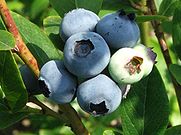**1. Berry Classification:**
– Berries have a rich history as a valuable food source since pre-agricultural times.
– Etymologically, the word ‘berry’ originates from Proto-Germanic *basjom.
– In botanical terms, a berry is a simple fruit with seeds and pulp.
– Culinary and botanical berries include blueberries, cranberries, and lingonberries.
– Some fruits like bananas, tomatoes, and grapes are botanical berries but not commonly known as berries.
– Poisonous berries like deadly nightshade and pokeweed exist in nature.
**2. Berry Cultivation and Production:**
– Berries like strawberries and blueberries have a long history of cultivation.
– Various berry types have been crossbred and domesticated over the years.
– Agricultural methods involve conventional and integrated pest management.
– Breeding aims to improve fruit size, yield, flavor, and disease resistance.
– Commercial production of berries spans millions of short tons globally.
– Challenges in labor recruitment and wages are prevalent in the berry industry.
**3. Berry Usage and Culinary Significance:**
– Berries are commonly used in pies, tarts, and baked goods.
– They are also utilized in beverages like cranberry juice and acai juice.
– Dried berries like currants and raisins are commercially important.
– Berries are preserved through various methods like drying, freezing, and pickling.
– Chefs use berries for pickling, frying, and making sauces like cranberry sauce.
**4. Health Benefits and Research:**
– Berry consumption is being researched for potential health benefits.
– Studies suggest berries can lower body mass index and blood pressure.
– Antioxidants in berries play a role in vascular function and reducing cardiovascular risk factors.
– Flavonoids and polyphenolics in berries offer possible health benefits.
– Marker-assisted selection aids in seedlessness in table grape breeding.
**5. Non-Food Applications and Cultural Significance:**
– Berries have historical significance in dyeing in various cultures.
– Native Americans used berries for dyeing tapa cloth.
– Berries are also used in botanical supplements and medicinal purposes.
– Blackberries and blueberries are used for natural dyeing.
– Berries have cultural and economic importance in regions like Maine and Hawaii.
A berry is a small, pulpy, and often edible fruit. Typically, berries are juicy, rounded, brightly colored, sweet, sour or tart, and do not have a stone or pit, although many pips or seeds may be present. Common examples of berries in the culinary sense are strawberries, raspberries, blueberries, blackberries, white currants, blackcurrants, and redcurrants. In Britain, soft fruit is a horticultural term for such fruits.
The common usage of the term "berry" is different from the scientific or botanical definition of a berry, which refers to a fruit produced from the ovary of a single flower where the outer layer of the ovary wall develops into an edible fleshy portion (pericarp). The botanical definition includes many fruits that are not commonly known or referred to as berries, such as grapes, tomatoes, cucumbers, eggplants, bananas, and chili peppers. Fruits commonly considered berries but excluded by the botanical definition include strawberries, raspberries, and blackberries, which are aggregate fruits, and mulberries, which are multiple fruits. Watermelons and pumpkins are giant berries that fall into the category "pepos". A plant bearing berries is said to be bacciferous or baccate.
Berries are eaten worldwide and often used in jams, preserves, cakes, or pies. Some berries are commercially important. The berry industry varies from country to country as do types of berries cultivated or growing in the wild. Some berries such as raspberries and strawberries have been bred for hundreds of years and are distinct from their wild counterparts, while other berries, such as lingonberries and cloudberries, grow almost exclusively in the wild.
While many berries are edible, some are poisonous to humans, such as deadly nightshade and pokeweed. Others, such as the white mulberry, red mulberry, and elderberry, are poisonous when unripe, but are edible when ripe.








